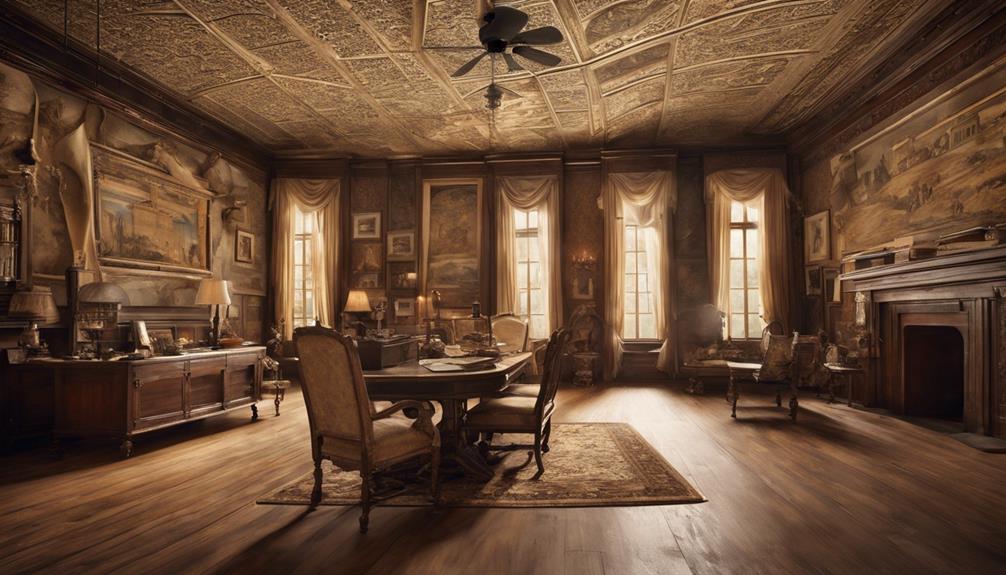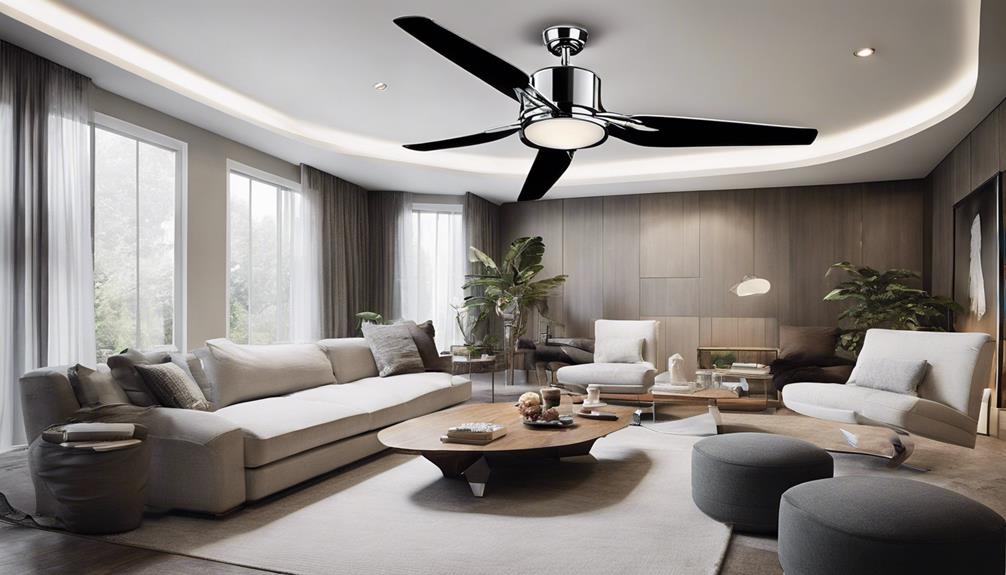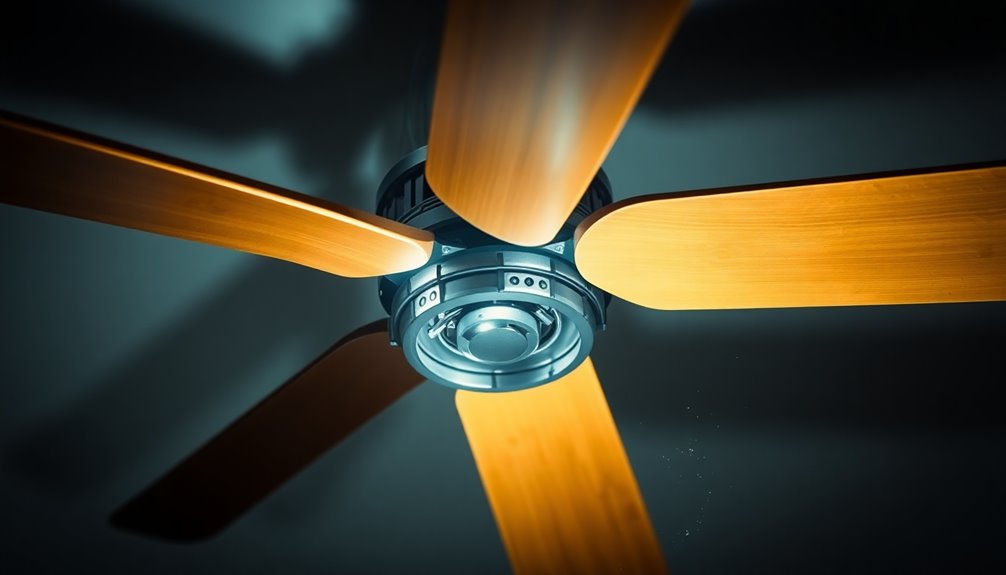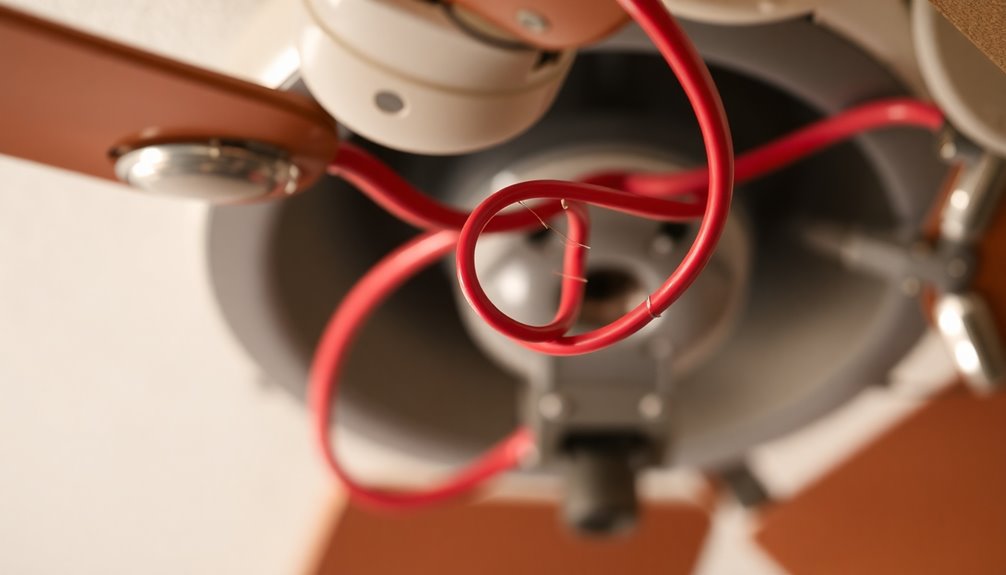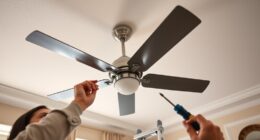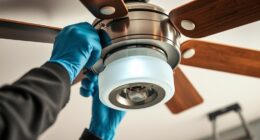Electric ceiling fans, a crucial development in modern cooling technology, were invented by Philip Diehl in 1882. Diehl's adaptation of a sewing machine motor for efficiency and modern designs laid the foundation for the widespread integration of electric motors. His 1889 patent further revolutionized cooling technology. The fan's evolution from ancient methods to mechanized models underscores its importance in maintaining indoor comfort. Understanding the history and advancements of ceiling fans can offer valuable insights for selecting the most suitable cooling solutions.
Key Takeaways
- Electric ceiling fans invented by Philip Diehl in 1882.
- Diehl adapted a sewing machine motor for efficiency and modern designs.
- Diehl's 1889 patent revolutionized cooling technology.
- Foundation for widespread adoption of electric motors.
- Significance of Diehl's invention in the evolution of fan technology.
Evolution of Cooling Technology
Revolutionizing cooling technology, the invention of electric ceiling fans by Philip Diehl in 1882 marked a significant advancement in home comfort. Diehl's innovation paved the way for a more efficient and accessible way to circulate air, improving indoor air quality and providing relief during hot summer months. As the first electric ceiling fans gained popularity, they quickly became a staple in households, offering a cost-effective cooling solution.
The evolution of cooling technology through electric ceiling fans showcased a shift towards more convenient and effective methods of maintaining comfortable indoor environments. While early ceiling fans in the US relied on water streams and turbine systems, Diehl's invention propelled the industry forward, setting the stage for further advancements in cooling systems.
With the rise of air conditioners in the 1950s, the usage of ceiling fans declined in the US. However, the legacy of Philip Diehl's invention continues to influence modern cooling technologies, highlighting the enduring impact of electric ceiling fans on home comfort.
Pre-Ceiling Fan Cooling Methods

Before the invention of ceiling fans, various cooling methods were utilized throughout history to combat heat and improve comfort in indoor spaces.
- Ancient Egyptians: Around 4,000 BC, ancient Egyptians used palm leaves to fan themselves, creating a breeze for cooling purposes.
- Human-Powered Mechanized Fans: In 180 A.D., the Chinese developed human-powered mechanized fans, a significant advancement in cooling technology for that time period.
- Ice Blocks for Cooling: In the 1830s, a doctor in Florida employed ice blocks to cool patients. This method was primitive but effective in providing relief from the heat.
These methods were the predecessors to the modern ceiling fan and electric fan. The journey from manual methods to mechanized cooling devices like fans showcases our continuous quest for comfort and innovation.
It wasn't until Schuyler Skaats Wheeler created the first electric fan in 1882 that a new era of cooling technology began, paving the way for the groundbreaking invention of the ceiling fan by Philip H. Diehl in 1889.
Philip H. Diehls Invention
After exploring the evolution of cooling methods leading up to the creation of the first electric ceiling fan, Philip H. Diehl's inventive breakthrough in 1882 propelled the industry into a new era of comfort and efficiency. Diehl's genius was in adapting a sewing machine motor to power the first electric ceiling fan, revolutionizing how people cooled their living spaces.
This marked a significant shift from the water or steam-powered fans of the past. Diehl's invention not only brought about enhanced efficiency but also set the stage for modern ceiling fans as we know them today. The integration of electric motors in ceiling fans represented a monumental leap in cooling technology, making the devices more accessible and practical for everyday use.
Diehl's pioneering work laid the foundation for the widespread adoption of ceiling fans in homes and commercial establishments, shaping the way we think about indoor comfort and air circulation.
Significance of 1889 Patent

The 1889 patent for the ceiling fan by Philip H. Diehl was a game-changer in the world of cooling technology.
This innovation not only impacted the way fans were designed but also set a new standard for electric cooling systems.
Diehl's patent laid the foundation for the widespread use of electric ceiling fans in both residential and commercial spaces.
Patent Impact on Fans
Issued in 1889, Philip Diehl's ceiling fan patent revolutionized the fan industry by introducing electric ceiling fans to the market. The impact of this patent was immense, shaping the future of fan technology and design.
Here are three ways Diehl's patent influenced the world of fans:
- Introduction of Electric Ceiling Fans: Diehl's patent marked a significant shift from manual to electric-powered fans, making them more convenient and efficient.
- Modern Designs: The 1889 patent laid the foundation for the development of modern ceiling fan designs, leading to sleeker and more functional fan models.
- Revolutionized Fan Industry: Diehl's innovation set the stage for the widespread adoption of electric ceiling fans, transforming how people cooled their homes.
Innovation in Cooling
Having revolutionized the way homes were cooled, Philip H. Diehl's 1889 patent for the ceiling fan integrated electric motors, ushering in a new era of efficient cooling systems.
Before Diehl's invention, ceiling fans relied on manual systems or water and steam energy for operation. The incorporation of electric motors in the patent marked a significant advancement in household comfort and technology.
This innovation not only improved the effectiveness of cooling but also laid the foundation for modern advancements in home cooling systems. Diehl's contribution with the ceiling fan and electric motor integration transformed the way we think about cooling our living spaces, making it more convenient and accessible for everyone.
The 1889 patent truly revolutionized the cooling industry, enhancing the quality of life for many.
Advancements in Fan Technology

Ceiling fan technology has come a long way since its inception in 1882. Fan designs have evolved significantly, incorporating features like adjustable speeds, remote controls, and even smart home integration.
Energy efficiency improvements have also been a key focus, with modern fans using less power while providing the same cooling effect.
Fan Design Evolution
Evolution in fan design technology has propelled the functionality and convenience of ceiling fans since the introduction of the first electric ceiling fan by Philip Diehl in 1882. These advancements have transformed the way we use and interact with ceiling fans, making them more efficient and user-friendly. Some notable developments include:
- Incorporation of remote controls: Modern ceiling fans now often come equipped with remote controls, allowing for easy operation from anywhere in the room.
- Introduction of reversible blade designs: The innovation of reversible blade designs enhances the fan's functionality, enabling users to adjust the airflow direction for different seasons.
- Integration of light fixtures: Many modern ceiling fans now feature integrated light fixtures, providing both illumination and air circulation in one convenient unit.
Energy Efficiency Improvements
As fan design technology has advanced, particularly with the introduction of BLDC motors, significant improvements in energy efficiency have revolutionized the operation of modern ceiling fans. BLDC motors consume less power than traditional induction motors, leading to reduced power consumption and enhanced sustainability.
These energy-efficient ceiling fans not only help lower electricity bills but also promote a quieter and more comfortable living environment. The evolution towards sustainable cooling solutions has propelled the development of modern ceiling fans that prioritize energy efficiency.
Home Comfort Revolution

During the Home Comfort Revolution, innovations like the electric ceiling fan by Philip Diehl transformed the way we experience cooling in our homes. These ceiling fans appeared at a time when air conditioning wasn't widely available, helping alleviate the discomfort caused by the energy crisis. Here are three key points about the impact of the first ceiling fan:
- Affordable Cooling Solutions: In the 1920s, ceiling fans gained popularity as an affordable way to cool households, providing a much-needed respite from the heat.
- Crucial Air Circulation: Before the widespread use of air conditioning, ceiling fans played a crucial role in circulating air and maintaining a comfortable environment indoors.
- Continuous Improvement: Over time, the design and technology of ceiling fans continued to evolve, offering enhanced comfort and efficiency for homeowners seeking relief from the heat.
The evolution of ceiling fans reflects our ongoing quest for better home comfort solutions, showcasing how a simple invention can make a significant difference in our daily lives.
Efficiency of Ceiling Fans

Ceiling fans' energy efficiency sets them apart as a cost-effective cooling solution compared to traditional air conditioning systems. While ceiling fans don't lower the air temperature, they create a cooling effect by circulating air and increasing airflow in a room. This can make you feel cooler without actually changing the temperature. What's impressive is that ceiling fans consume significantly less energy than air conditioning units, making them a more energy-efficient choice for keeping cool.
Additionally, ceiling fans can be multifunctional, serving as both cooling and lighting sources. Many ceiling fan models come with built-in light fixtures, offering a dual-purpose solution that can help save energy and reduce electricity costs. During colder months, ceiling fans can even be used to push down warm air trapped near the ceiling, helping to distribute heat more evenly throughout the room and potentially reducing the need for extra heating. This versatility and efficiency make ceiling fans a practical and economical choice for maintaining a comfortable living environment.
Widespread Cooling Solution

Efficiently revolutionizing the way spaces were cooled, the invention of electric ceiling fans by Philip Diehl in the 1880s paved the path for a widespread cooling solution that quickly gained popularity for its ability to circulate air and provide comfort in various environments. The integration of electric motors into ceiling fans marked a significant shift towards more efficient and affordable cooling solutions.
Here are three key reasons why electric ceiling fans became a favored choice for cooling:
- Energy Efficiency: Electric ceiling fans are known for their energy efficiency, consuming much less electricity compared to air conditioning units, making them a cost-effective cooling solution.
- Versatile Cooling: These fans are versatile in their ability to circulate air effectively, providing comfort in both residential and industrial settings, catering to a wide range of cooling needs.
- Affordability: Electric ceiling fans are an affordable option for maintaining a comfortable environment, offering a budget-friendly cooling solution for many households and businesses.
Impact on Household Cooling

Ceiling fans have been a game-changer for household cooling, providing energy-efficient solutions that improve indoor air circulation. They're a cost-effective option for maintaining a comfortable environment while reducing electricity consumption.
As technology advances, the development of energy-efficient fan models aims to enhance cooling efficiency and lower maintenance requirements.
Energy-Efficient Cooling Solution
Revolutionizing household cooling solutions, ceiling fans have significantly impacted energy consumption and cost savings.
- Energy Efficiency: Ceiling fans are known for their energy-efficient operation, consuming only a fraction of the energy compared to traditional air conditioning units.
- BLDC Motors: The development of energy-efficient ceiling fans with Brushless DC (BLDC) motors has further enhanced their efficiency, reducing electricity consumption in households.
- Cost-Effectiveness: In regions like India with hot climates, ceiling fans are a popular choice for primary cooling due to their cost-effectiveness, providing practical cooling benefits while saving on energy costs.
Ceiling fans, equipped with advanced technologies like BLDC motors, offer a sustainable and budget-friendly solution for household cooling needs, ensuring comfort without compromising on energy efficiency.
Improving Indoor Air Circulation
Improving indoor air circulation can significantly enhance household cooling efficiency and comfort. Ceiling fans, invented in the 1880s, play a crucial role in maintaining a pleasant indoor environment. By circulating air and creating a gentle breeze, ceiling fans help occupants feel cooler without lowering the room temperature.
These energy-efficient devices are a cost-effective cooling solution for households. Proper placement and use of ceiling fans can optimize air circulation, making rooms feel more comfortable during hot weather. With their ability to complement air conditioning units or be used on their own, ceiling fans are a valuable addition to any household seeking efficient cooling solutions.
Cost-Effective Cooling Option
Introducing a cost-effective cooling option that has stood the test of time: the humble ceiling fan.
Ceiling fans were introduced in the late 19th century as a budget-friendly way to cool households. They're energy-efficient, consuming less power than air conditioning units. Despite technological advancements, ceiling fans remain popular for their affordability and effectiveness in providing comfort.
Many households globally rely on ceiling fans as a staple for residential cooling solutions.
Historical Context of Ceiling Fans

In the historical context of ceiling fans, the punkah style fans originating in India around 500 BC were manually operated. These early fans were simple yet effective, with individuals pulling a rope or cord to swing the fan back and forth, providing a cooling breeze.
Fast forward to the 1860s in the United States, where the first rotary ceiling fans emerged, initially powered by water or steam energy. The introduction of electrically powered ceiling fans in 1882 by Philip Diehl marked a significant milestone, leading to the modern motor ceiling fan we're familiar with today.
As time progressed, ceiling fans became a common sight in the US, particularly in regions with hot climates such as the South. Despite the advent of air conditioning, countries like India continued to embrace ceiling fans due to their energy efficiency and effectiveness in circulating air. The legacy of the punkah style fan lives on in the design and function of modern ceiling fans, providing both comfort and style to homes worldwide.
Early Cooling Innovations

Moving from the historical context of ceiling fans to the realm of early cooling innovations reveals a fascinating evolution in the quest for efficient air circulation solutions.
- First Electrically Powered Ceiling Fan: The introduction of the first electrically powered ceiling fan by Philip Diehl in 1882 marked a significant milestone in the history of cooling innovations. This innovation paved the way for more convenient and effective air circulation in homes and workplaces.
- Two Blades Design: In the early 1860s, ceiling fans with two blades were developed in the US. These fans were powered by a water stream and turbine system, providing a rudimentary yet functional cooling solution for indoor spaces.
- Motor Ceiling Fan: The invention of the motor ceiling fan revolutionized the industry, offering improved performance and durability compared to earlier manual or water-powered designs. This innovation set the stage for the modern ceiling fan designs we use today.
Development of Fan Technology

The evolution of fan technology has continually refined the efficiency and functionality of these cooling devices. From the early belt-operated systems in the 1860s to the groundbreaking electric ceiling fan by Philip Diehl in 1882, advancements in motor and electric technology have transformed the way we cool our spaces. In the 1920s, the shift to four-bladed fans improved performance and reduced noise levels, making them more appealing to consumers. However, the 1950s saw a decline in ceiling fan usage with the rise of air conditioning units.
To showcase the evolution of fan technology, consider the following table:
| Year | Technological Advancement |
|---|---|
| 1860s | Belt-operated rotary fans |
| 1882 | Invention of the electric ceiling fan with a sewing machine motor |
| 1920s | Transition to quieter and more efficient four-bladed fans |
| Present | Energy-efficient models with advanced motor technology |
These advancements highlight the continuous innovation in fan technology, leading to more energy-efficient models that cater to modern needs.
Consumer Options in Cooling

Exploring the diverse range of cooling options available to consumers reveals the versatility and functionality of modern ceiling fans. These innovative devices offer much more than just air circulation; they enhance the comfort and style of any room. Here are three key features that make modern ceiling fans a top choice for consumers:
- Variety of Designs: Modern ceiling fans come in a wide array of designs and styles, catering to different tastes and home aesthetics. Whether you prefer a sleek contemporary look or a more traditional feel, there's a ceiling fan to complement your decor.
- Reversible Blades: With reversible blades, these fans can be used not only for cooling in the summer but also for circulating warm air during the winter months. This feature adds to the efficiency and year-round usefulness of ceiling fans.
- Remote Control Functionality: Many modern ceiling fans are equipped with remote control capabilities, offering convenience and ease of use. Adjusting fan speed, changing direction, or turning on lights can all be done with the push of a button, enhancing the overall consumer experience.
Improving Indoor Temperatures

Enhancing indoor comfort through efficient temperature control methods can significantly improve the overall living experience. Indoor air circulation plays a crucial role in maintaining pleasant temperatures, and ceiling fans are a great way to achieve this.
Originally invented by Philip Diehl in the 1880s, ceiling fans were designed to increase air speed rather than lower air temperature. They create a cooling effect by aiding in sweat evaporation, making rooms feel more comfortable. Additionally, during winter, ceiling fans can help redistribute warmer air, reducing the need for excessive heating.
These energy-efficient devices have become popular for improving indoor temperatures while being environmentally friendly.
Frequently Asked Questions
What Did People Use Before Ceiling Fans?
Before ceiling fans, people relied on handheld fans for pre-electric cooling. They also utilized wind-powered ventilation, evaporative cooling methods, and mechanical air circulation systems.
These methods helped manage indoor temperatures before the invention of electric ceiling fans. The evolution of cooling technologies has provided more efficient and convenient ways to circulate air in homes and buildings, offering improved comfort and airflow.
Were There Ceiling Fans in the 1920s?
Oh, ceiling fans in the 1920s were a game-changer! Technological advancements took air circulation to new heights, making them not just a cooling solution but a trendy home decor essential.
The design evolution ensured they were both practical and stylish. It was like having a sleek breeze generator right in your living room!
Were There Ceiling Fans in the 60s?
In the 60s, ceiling fans were more than just retro design; they were an integral part of pop culture and interior trends. Despite advancing technology like air conditioning, ceiling fans remained a popular cooling solution in hot climates.
Companies like Hunter Fan and Westinghouse commercialized sales, making them accessible to many households. The 60s marked a period where ceiling fans continued to offer practical and cost-effective cooling solutions for homes.
When Did Fans Become Common?
Ceiling fans became common in residential properties due to their energy efficiency, air circulation benefits, design evolution, and modern technology. Popular models offered affordable cooling solutions, making them a staple in many households.
Despite the rise of air conditioners, ceiling fans remained popular, especially in hot climates like India. The continuous improvement in design and technology ensured that ceiling fans were and continue to be a crucial cooling system for many.
How Have Ceiling Fans Evolved from Traditional to Bladeless Designs?
Ceiling fans have come a long way, with bladeless ceiling fans gaining popularity in recent years. These modern designs have evolved from traditional models, offering a sleek and innovative alternative. By eliminating blades, these fans are not only safer but also more efficient and quieter, making them a popular choice for modern homes.
Conclusion
In conclusion, the invention of ceiling fans in 1889 revolutionized indoor cooling technology, making hot summer days bearable for households around the world.
Without ceiling fans, we'd be left sweltering in the heat, unable to escape the oppressive temperatures.
Thank goodness for the innovative minds that brought us this simple yet essential invention!
